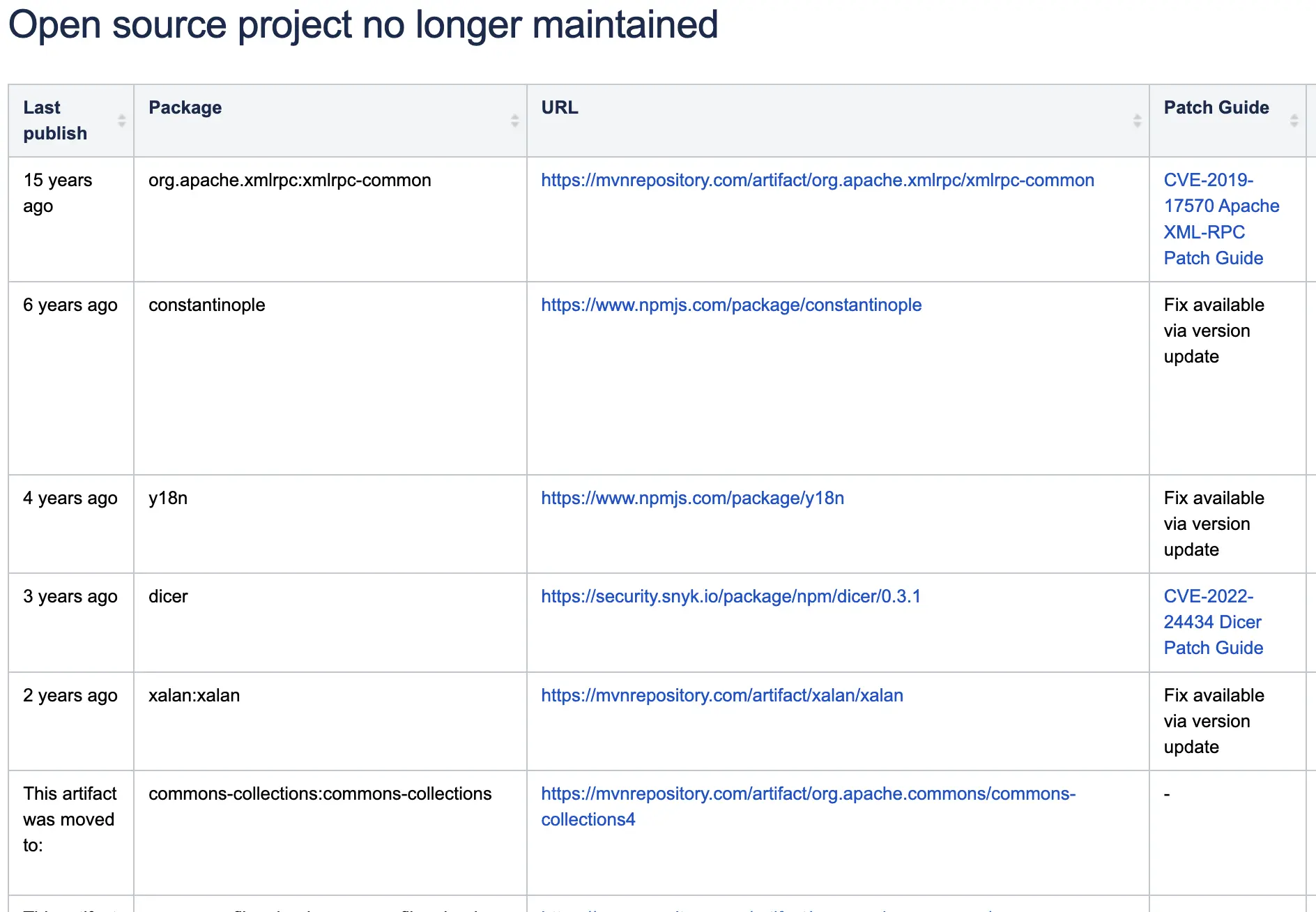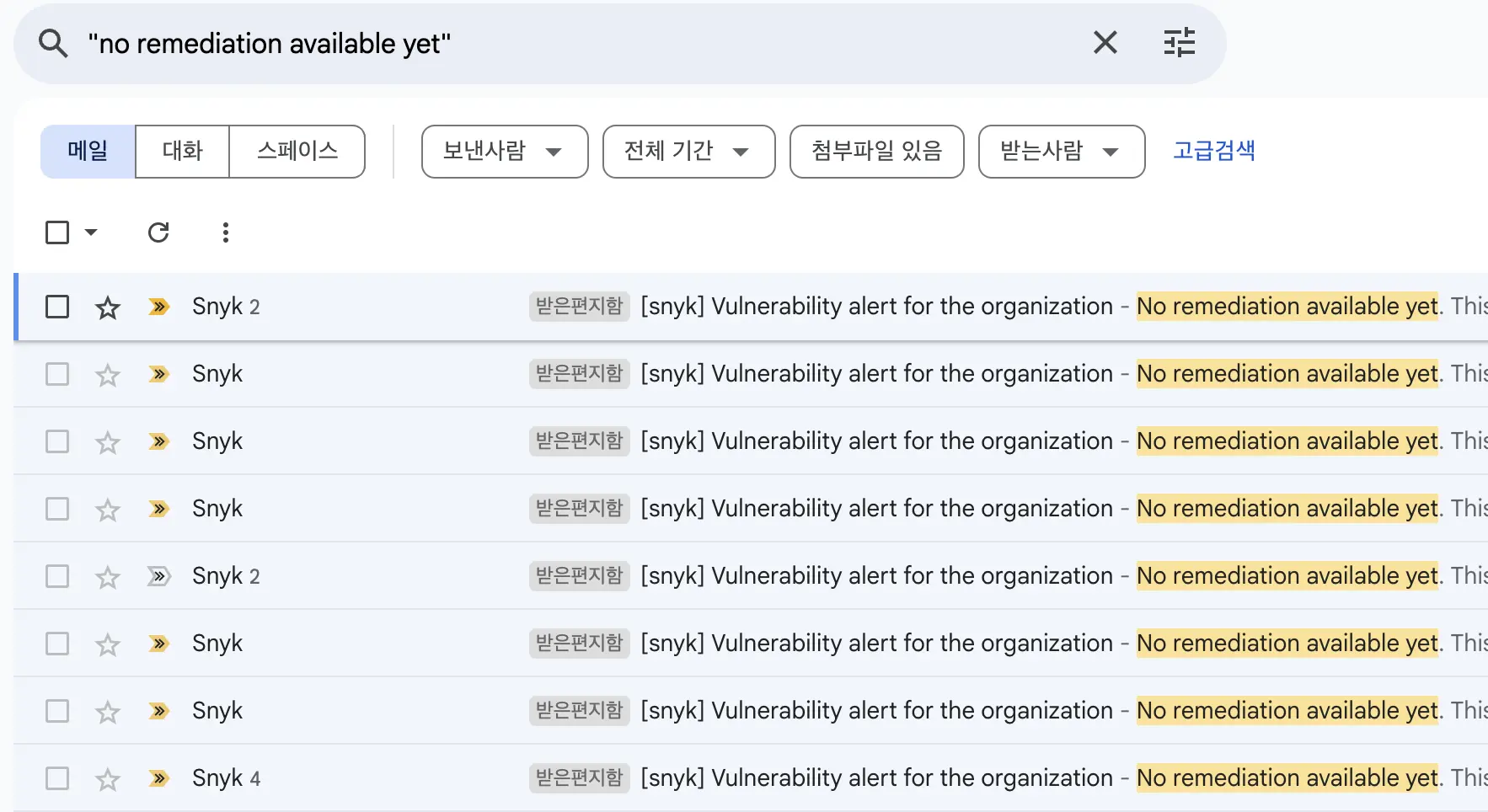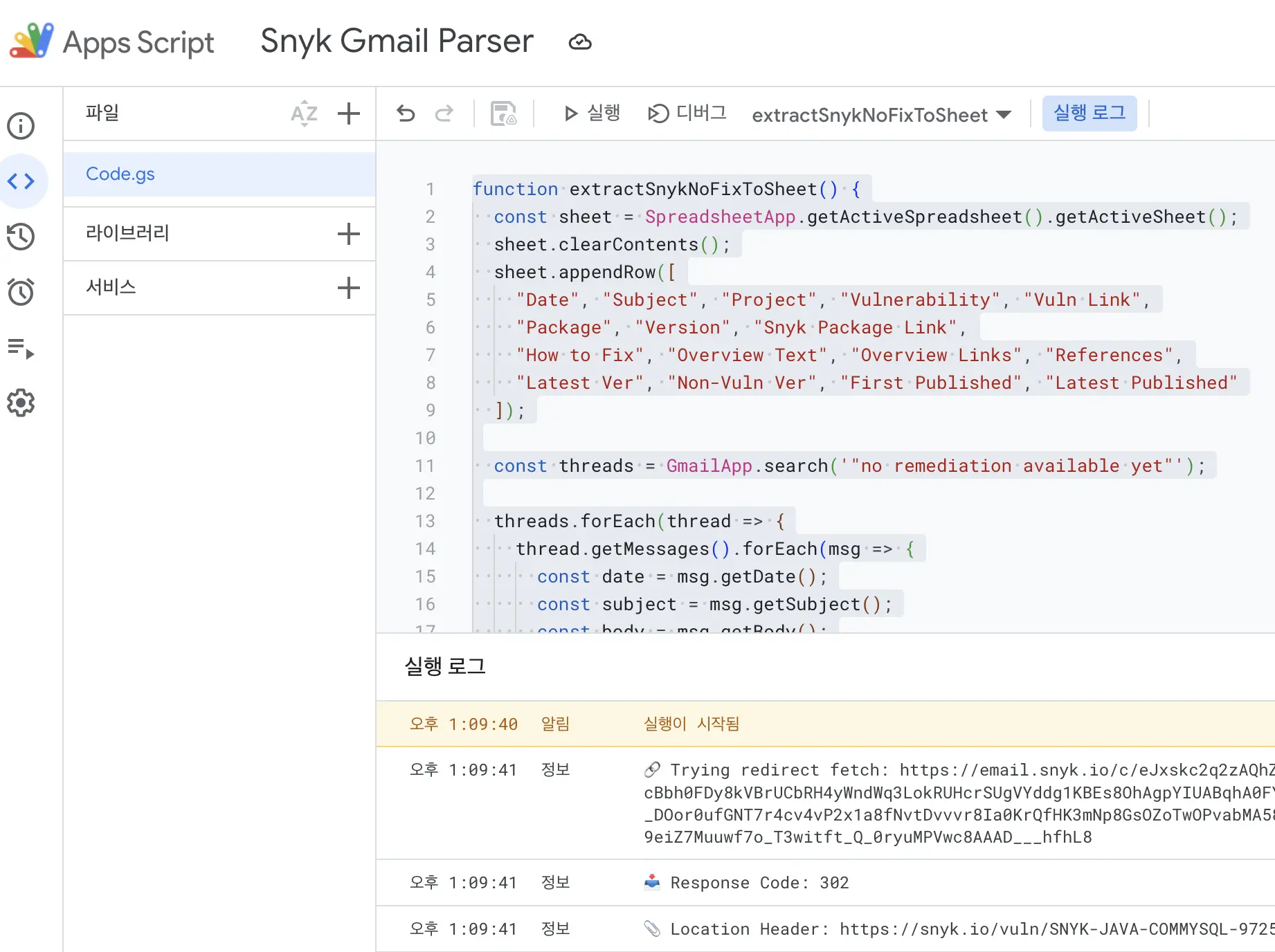
Motivation
I initially assumed that Snyk’s alerts could be fully automated through their official API. But API alone couldn’t handle everything I needed. Many useful details—including “How to Fix”, “Overview” descriptions, and safe versions—were easier to extract from the web interface.
Since this gap couldn’t be bridged via API, I built an automated parser using Gmail and Google Apps Script. This method reads the contents of emails containing the phrase “no remediation available yet” and scrapes all relevant data from the linked vulnerability page.
What It Does
Searches Gmail for Snyk alerts that mention “no remediation available yet”
Follows the redirect link to the Snyk vulnerability page
Parses:
- Vulnerability name & link
- Affected package & version
- Fix suggestions (via structured FAQ JSON-LD)
- Overview text & references
- Latest version info (latest, non-vulnerable, publish dates)
Outputs all collected data to Google Sheets
Screenshot Examples
Gmail Search Results

Apps Script Running

Output Google Sheet

Full Code
1
2
3
4
5
6
7
8
9
10
11
12
13
14
15
16
17
18
19
20
21
22
23
24
25
26
27
28
29
30
31
32
33
34
35
36
37
38
39
40
41
42
43
44
45
46
47
48
49
50
51
52
53
54
55
56
57
58
59
60
61
62
63
64
65
66
67
68
69
70
71
72
73
74
75
76
77
78
79
80
81
82
83
84
85
86
87
88
89
90
91
92
93
94
95
96
97
98
99
100
101
102
103
104
105
106
107
108
109
110
111
112
113
114
115
116
117
118
119
120
121
122
123
124
125
126
127
128
129
130
131
132
133
134
135
136
137
138
139
function extractSnykNoFixToSheet() {
const sheet = SpreadsheetApp.getActiveSpreadsheet().getActiveSheet();
sheet.clearContents();
sheet.appendRow([
"Date", "Subject", "Project", "Vulnerability", "Vuln Link",
"Package", "Version", "Snyk Package Link",
"How to Fix", "Overview Text", "Overview Links", "References",
"Latest Ver", "Non-Vuln Ver", "First Published", "Latest Published"
]);
const threads = GmailApp.search('"no remediation available yet"');
threads.forEach(thread => {
thread.getMessages().forEach(msg => {
const date = msg.getDate();
const subject = msg.getSubject();
const body = msg.getBody();
const iconBlockMatch = body.match(/<img[^>]+icon-cli\.webp[^>]*>[\s\S]*?<strong[^>]*>(.*?)<\/strong>/i);
const project = iconBlockMatch ? iconBlockMatch[1].trim() : "";
const vulnMatch = body.match(/<img[^>]+icon-vuln\.webp[^>]*>[\s\S]{0,300}?<a[^>]+href="([^"]+)"[^>]*>(.*?)<\/a>/i);
let vulnUrl = vulnMatch ? vulnMatch[1].trim() : "";
const vulnName = vulnMatch ? vulnMatch[2].trim() : "";
const packageMatch = body.match(/Vulnerability in (@?[a-zA-Z0-9_.:\/\-]+)\s+([0-9][a-zA-Z0-9.\-_]*)/);
const pkgName = packageMatch ? packageMatch[1].trim() : "";
const pkgVer = packageMatch ? packageMatch[2].trim() : "";
let howToFix = "", overviewText = "", overviewLinks = "", references = "", subtitleMatch, snykPkgLink;
let latestVer = "", nonVulnVer = "", firstPublished = "", latestPublished = "";
try {
Logger.log(`🔗 Trying redirect fetch: ${vulnUrl}`);
const resp = UrlFetchApp.fetch(vulnUrl, {
followRedirects: false,
muteHttpExceptions: true
});
const status = resp.getResponseCode();
const headers = resp.getAllHeaders();
const redirected = headers["Location"] || headers["location"] || vulnUrl;
Logger.log(`📥 Response Code: ${status}`);
Logger.log(`📎 Location Header: ${redirected}`);
vulnUrl = redirected;
} catch (e) {
Logger.log(`🔥 Exception during redirect check for ${vulnUrl}: ${e}`);
}
try {
const html = UrlFetchApp.fetch(vulnUrl).getContentText();
Logger.log(`📄 HTML content preview (first 1000 chars):\n${html.slice(0, 1000)}`);
subtitleMatch = html.match(/<span[^>]*subheading[^>]*>.*?<a[^>]+href="([^"]+)"[^>]*>(.*?)<\/a>/i);
snykPkgLink = subtitleMatch ? "https://security.snyk.io" + subtitleMatch[1] : "";
Logger.log(`🔎 subtitleMatch: ${subtitleMatch}`);
Logger.log(`🔗 snykPkgLink: ${snykPkgLink}`);
howToFix = extractFixFromScriptJson(html);
Logger.log(`✅ How to Fix: ${howToFix}`);
const overviewResult = extractSectionLinks(html, "Overview");
overviewText = overviewResult.text;
overviewLinks = overviewResult.links.join(", ");
Logger.log(`✅ Overview Text: ${overviewText}`);
Logger.log(`✅ Overview Links: ${overviewLinks}`);
const refsResult = extractSectionLinks(html, "References");
references = refsResult.links.join(", ");
Logger.log(`✅ References: ${references}`);
if (snykPkgLink) {
const pkgHtml = UrlFetchApp.fetch(snykPkgLink).getContentText();
const valueFromLabel = (label) => {
const allMatches = [...pkgHtml.matchAll(/<li[^>]*data-snyk-test="DetailsBoxItem: ([^"]+)"[^>]*>[\s\S]*?<h3[^>]*>(.*?)<\/h3>[\s\S]*?<[^>]+>(.*?)<\//g)];
for (const m of allMatches) {
if (m[2]?.toLowerCase().includes(label)) return m[3].replace(/<[^>]+>/g, "").trim();
}
return "";
};
latestVer = valueFromLabel("latest version");
nonVulnVer = valueFromLabel("latest non vulnerable version");
firstPublished = valueFromLabel("first published");
latestPublished = valueFromLabel("latest version published");
Logger.log(`📦 Snyk Versions - Latest: ${latestVer}, Non-Vuln: ${nonVulnVer}, First: ${firstPublished}, Latest Pub: ${latestPublished}`);
}
} catch (e) {
Logger.log(`🔥 Exception fetching redirected content for ${vulnUrl}: ${e}`);
}
const row = [date, subject, project, vulnName, vulnUrl, pkgName, pkgVer, snykPkgLink, howToFix, overviewText, overviewLinks, references, latestVer, nonVulnVer, firstPublished, latestPublished];
sheet.appendRow(row);
});
});
}
function extractFixFromScriptJson(html) {
const matches = [...html.matchAll(/<script[^>]+type="application\/ld\+json"[^>]*>(.*?)<\/script>/g)];
for (const match of matches) {
try {
const json = JSON.parse(match[1]);
const graph = json["@graph"] || [];
for (const node of graph) {
if (node["@type"] === "FAQPage" && node.mainEntity?.length) {
for (const q of node.mainEntity) {
if (q.name?.toLowerCase().includes("how to fix") && q.acceptedAnswer?.text) {
return q.acceptedAnswer.text.replace(/<[^>]+>/g, "").replace(/\s+/g, " ").trim();
}
}
}
}
} catch (e) {
Logger.log("❌ Failed to parse How to Fix from JSON-LD block: " + e);
}
}
Logger.log("❌ No matching How to Fix found in JSON-LD blocks");
return "";
}
function extractSectionLinks(html, sectionTitle) {
const pattern = new RegExp(`<h2[^>]*>\\s*.{0,10}${sectionTitle}.{0,10}\\s*<\\/h2>[\\s\\S]{0,2000}?<div[^>]*class=\"markdown-to-html[^"]*\"[^>]*>([\\s\\S]*?)<\\/div>`, "gi");
const matches = [...html.matchAll(pattern)];
if (matches.length === 0) {
Logger.log(`❌ Section "${sectionTitle}" not found.`);
return { text: "", links: [] };
}
const content = matches[0][1];
Logger.log(`🔍 Matched HTML block for ${sectionTitle}:\n${content.slice(0, 500)}`);
const fragment = HtmlService.createHtmlOutput(content).getContent();
const linkMatches = [...fragment.matchAll(/<a[^>]+href="([^"]+)"[^>]*>/g)];
const links = linkMatches.map(m => m[1]);
const text = content.replace(/<[^>]+>/g, "").replace(/\s+/g, ' ').trim();
return { text, links };
}
How It Works
1. Gmail Parsing
const threads = GmailApp.search('"no remediation available yet"');
Searches for relevant Snyk alert emails.
2. Extracting Vulnerability Metadata
const vulnMatch = body.match(...);
Grabs the vulnerability name and URL from the email body.
3. Following Redirect
const resp = UrlFetchApp.fetch(vulnUrl, { followRedirects: false });
vulnUrl = resp.getAllHeaders()["Location"];
Snyk uses redirect links in emails. I follow them manually.
4. Extracting “How to Fix” from JSON-LD
const json = JSON.parse(match[1]);
This looks into embedded <script type="application/ld+json"> blocks to get FAQ text.
5. Overview & References Section
extractSectionLinks(html, "Overview");
Regex-based static scraping of the structured HTML overview block.
6. Snyk Package Page Metadata
const pkgHtml = UrlFetchApp.fetch(snykPkgLink).getContentText();
Fetches info like:
- Latest version
- Latest non-vulnerable version
- First published
- Latest published
Real-World Use Case
I used this tool to track vulnerable packages and write actionable guides for open source libraries that are no longer maintained and have no official fixes:
Want to Try It?
- Use your Gmail account with access to Snyk alerts
- Set up a Google Apps Script
- Paste the
extractSnykNoFixToSheet()function into the script editor - Run it and inspect your Google Sheet
No API keys, no scraping with Playwright or Puppeteer. Just email + code.
✋ If you’ve tackled a similar challenge, let me know how you did it differently!